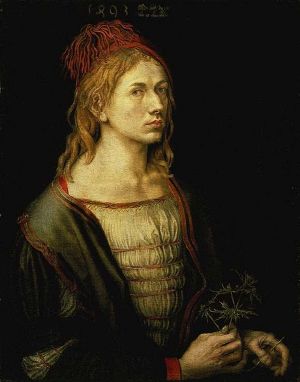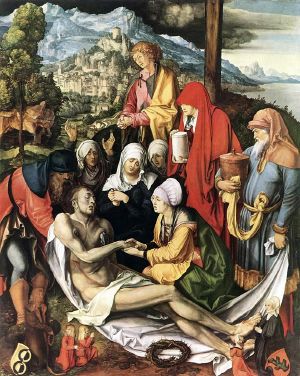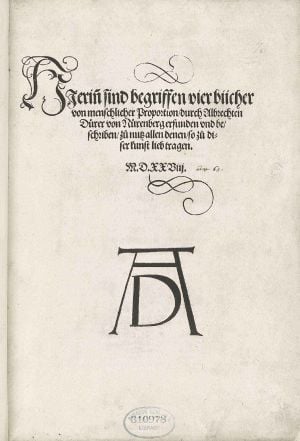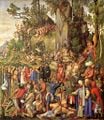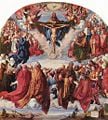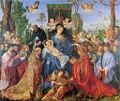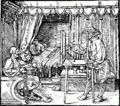Durer, Albrecht
(1st 100) |
|||
| Line 22: | Line 22: | ||
| awards = | | awards = | ||
}} | }} | ||
| − | '''Albrecht Dürer''' (May 21, 1471 – April 6, 1528) <ref name=Mueller>Mueller, Peter O. (1993) ''Substantiv-Derivation in Den Schriften Albrecht Durers'', Walter de Gruyter. ISBN 3-11-012815-2.Retrieved October 18, 2007.</ref> was a [[Germany|German]] [[painting|painter]] and [[mathematician]] who is considered one of the greatest creators of [[old master print]]s. He often executed his works in series, including the ''Apocalypse'' (1498) and his two series on the passion of Christ, the ''Great Passion'' (1498–1510) and the ''Little Passion'' (1510–1511). Dürer's best known individual [[engraving]]s include ''[[:Image:Duerer - Ritter, Tod und Teufel (Der Reuther).jpg|Knight, Death, and the Devil]]'' (1513), ''[[:Image:Hieronymus Albrect Dürer 1514.jpg|Saint Jerome in his Study]]'' (1514) and ''[[Melencolia I]]'' (1514). His most iconic images are his woodcuts of the ''[[:Image:Duerer-apocalypse.png|Four Horsemen of the Apocalypse]]'' (1497–1498) from the ''Apocalypse'' series, the "[[Dürer's Rhinoceros|Rhinoceros]] | + | '''Albrecht Dürer''' (May 21, 1471 – April 6, 1528) <ref name=Mueller>Mueller, Peter O. (1993) ''Substantiv-Derivation in Den Schriften Albrecht Durers'', Walter de Gruyter. ISBN 3-11-012815-2.Retrieved October 18, 2007.</ref> was a [[Germany|German]] [[painting|painter]] and [[mathematics|mathematician]] who is considered one of the greatest creators of [[old master print]]s. He often executed his works in series, including the ''Apocalypse'' (1498) and his two series on the passion of Christ, the ''Great Passion'' (1498–1510) and the ''Little Passion'' (1510–1511). Dürer's best known individual [[engraving]]s include ''[[:Image:Duerer - Ritter, Tod und Teufel (Der Reuther).jpg|Knight, Death, and the Devil]]'' (1513), ''[[:Image:Hieronymus Albrect Dürer 1514.jpg|Saint Jerome in his Study]]'' (1514) and ''[[Melencolia I]]'' (1514). His most iconic images are his woodcuts of the ''[[:Image:Duerer-apocalypse.png|Four Horsemen of the Apocalypse]]'' (1497–1498) from the ''Apocalypse'' series, the "[[Dürer's Rhinoceros|Rhinoceros]]". Additionally, he painted a number of religious works and self portraits in oil and created many brilliant [[watercolor painting|watercolor]]s and drawings, which now through [[modernism|modern]] reproductions are perhaps his best known works. |
| − | He has been conventionally regarded as the greatest artist of the [[Renaissance]] in Northern [[Europe]]. His work | + | He has been conventionally regarded as the greatest artist of the [[Renaissance]] in Northern [[Europe]]. His work reflect the [[apocalypticism|apocalyptic]] spirit of his time, when [[famine]], [[Bubonic plague|plague]], and social and religious upheaval were common. |
== Early life == | == Early life == | ||
Revision as of 15:50, 18 November 2007
| Albrecht Dürer | |
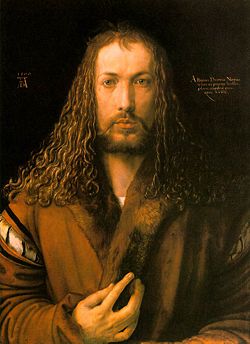 Self-Portrait (1500) by Albrecht Dürer, oil on board, Alte Pinakothek, Munich | |
| Birth name | Albrecht Dürer |
| Born | May 21 1471 Nuremberg, Germany |
| Died | April 6 1528 (aged 56) Nuremberg, Germany |
| Nationality | |
| Field | Printmaking, Painting |
| Famous works | Knight, Death, and the Devil (1513)
Saint Jerome in his Study (1514) Melencolia I (1514) Dürer's Rhinoceros |
Albrecht Dürer (May 21, 1471 – April 6, 1528) [1] was a German painter and mathematician who is considered one of the greatest creators of old master prints. He often executed his works in series, including the Apocalypse (1498) and his two series on the passion of Christ, the Great Passion (1498–1510) and the Little Passion (1510–1511). Dürer's best known individual engravings include Knight, Death, and the Devil (1513), Saint Jerome in his Study (1514) and Melencolia I (1514). His most iconic images are his woodcuts of the Four Horsemen of the Apocalypse (1497–1498) from the Apocalypse series, the "Rhinoceros". Additionally, he painted a number of religious works and self portraits in oil and created many brilliant watercolors and drawings, which now through modern reproductions are perhaps his best known works.
He has been conventionally regarded as the greatest artist of the Renaissance in Northern Europe. His work reflect the apocalyptic spirit of his time, when famine, plague, and social and religious upheaval were common.
Early life
Dürer was born on May 21, 1471, third child and second son of his parents, who had between fourteen and eighteen children. His father was a successful goldsmith, who in 1455 had moved to Nuremberg from Ajtós, near Gyula in Hungary. Albrecht Dürer the Elder married Barbara Holper, from a prosperous Nuremberg family, in 1467.
After a few years of school, Dürer started to learn the basics of goldsmithing and drawing from his father. Though his father wanted him to continue his training as a goldsmith, he showed such a precocious talent in drawing that he started as an apprentice to Michael Wolgemut at the age of fifteen in 1486. A superb self-portrait, a drawing in silverpoint, is dated 1484 (Albertina, Vienna) “when I was a child,” as his later inscription says. Wolgemut was the leading artist in Nuremberg at the time, with a large workshop producing a variety of works of art, in particular woodcuts for books. Nuremberg was a prosperous city, a center for publishing and many luxury trades. It had strong links with Italy, especially Venice, a relatively short distance across the Alps.[2]
To Italy and Back
In 1494, he left Germany to study the art of Italy. [3] He returned to Nuremberg in 1495, opened up his own workshop, and over the next five years his style increasingly integrated Italian influences with underlying Northern forms. His best works in the early years were his woodcut prints, which were mostly religious, but included some secular scenes such as, The Mens Bath-house (c1496). These were larger than the great majority of German woodcuts done up until this time, they were far more complex and balanced in composition.
It is now thought highly unlikely that Dürer would have cut any of the woodblocks himself; instead this task would have been left to a craftsman. His training in Wolgemut's studio, which created many carved and painted altarpieces, evidently gave him experience in this technique and its potential. Dürer either drew his design directly onto the woodblock itself, or glued a paper drawing to the block. Either way his original drawings were destroyed during the cutting of the block.
His famous series of sixteen great designs for the Apocalypse are dated 1498. He made the first seven scenes of the Great Passion in the same year, and a little later, a series of eleven on the Holy Family and saints. Around 1503–1505 he produced the first seventeen of a set illustrating the life of the Virgin, which he did not finish for some years. Neither these, nor the Great Passion, were published as sets until several years later, however, prints were sold individually in considerable numbers.[2]
During the same period Dürer trained himself in the difficult art of using the burin to make engravings. The first few were relatively unambitious, but by 1496 he produced the masterpiece, the Prodigal Son. He was soon producing some spectacular images, notably, Nemesis (1502), The Sea Monster (1498), and Saint Eustace (1501), which has a highly detailed landscape background and beautiful animals. He made a number of Madonnas, single religious figures, and small scenes with comic peasant figures. These prints which were highly portable made Dürer famous throughout the main artistic centers of Europe within a short period of time.[2]
The Venetian artist Jacopo de' Barbari, whom Dürer had met in Venice, visited Nuremberg in 1500, and Dürer said that he learned much about the new developments in perspective, anatomy, and proportion His study of this field would become a lifelong preoccupation. A series of extant drawings show Dürer's experiments in human proportion, leading to the famous engraving of, Adam and Eve (1504). This is the only existing engraving signed with his full name.
Dürer made large numbers of preparatory drawings, especially for his paintings and engravings, many of which have survived. One of the most well known is the Praying Hands (1508 Albertina, Vienna. He also continued to make images in watercolor and bodycolour. An exquisite sill life of a meadow is his "Hare" (1502, Albertina, Vienna).
Second visit to Italy
In Italy, he returned to painting, at first producing them on linen. These include portraits and altarpieces, notably, the Paumgartner altarpiece and the Adoration of the Magi. In early 1506, he returned to Venice and stayed there until the spring of 1507.[1] By this time Dürer's engravings had attained great popularity and were being copied. In Venice he was given a valuable commission from the emigrant German community for the church of St. Bartholomew. The picture painted by Dürer was closer to the Italian style—the Adoration of the Virgin, also known as the Feast of Rose Garlands. It was subsequently acquired by the Emperor Rudolf II and taken to Prague. Other paintings Dürer produced in Venice include, The Virgin and Child with the Goldfinch, Christ disputing with the Doctors (supposedly produced in a mere five days), and a number of smaller works.
Nuremberg and the masterworks
Despite his popularity with the Venetians, Dürer was back in Nuremberg by mid-1507 where he remained until 1520. His reputation had spread throughout Europe and in communicated with most of the major artists of the time even exchaning drawings with Raphael.
The years between his return from Venice and his journey to the Netherlands are divided according to the type of work he did. The first five years, 1507–1511, are pre-eminently the painting years of his life. He worked with a vast number of preliminary drawings and studies and produced what have been called his four greatest works in painting, Adam and Eve (1507), Virgin with the Iris (1508), the altarpiece the Assumption of the Virgin (1509), and the Adoration of the Trinity by all the Saints (1511). During this period he also completed the two woodcut series, the Great Passion and the Life of the Virgin, both published in 1511.
However, Durer complained that painting did not make enough money to justify the time spent, so from 1511 to 1514 he concentrated on printmaking and engraving. The major works he produced in this period were the thirty-seven woodcut subjects of the Little Passion, published first in 1511, and a set of fifteen small engravings of the same theme in 1512. In 1513 and 1514 he created his three most famous engravings, The Knight, Death, and the Devil (or simply, The Knight, as he called it, 1513), the enigmatic and much analyzed Melencolia I, and St. Jerome in his Study (both 1514).[2]
In 'Melencolia I' appears a fourth-order magic square which is believed to be the first seen in European art. The two numbers in the middle of the bottom row give the date of the engraving, 1514.
In 1515, he created a woodcut of a Rhinoceros from a written description and brief sketch, without ever seeing the animal depicted. Despite being relatively inaccurate (the animal belonged to a now extinct Indian species), the image has such force that it remains one of his best-known, and was still being used in some German school science text-books early in the last century.[2]
In the years leading to 1520 he produced a wide range of works, including portraits in tempera on linen in 1516, engravings on many subjects, a few experiments in etching on plates of iron, and parts of the Triumphal Arch and the Triumphs of Maximilian which were projects directly commissioned by Maximilian I, Holy Roman Emperor. He drew marginal decorations for some pages of an edition of the Emperor's printed prayer book. These were quite unknown until facsimiles were published in 1808 as the first book ever published in lithography. The decorations show a lighter, more fanciful, side to Dürer's art, as well as, his usual superb draftsmanship. He also drew a portrait of the Emperor Maximilian, shortly before his death, in 1519.
Journey to the Netherlands and beyond
In the summer of 1520 Dürer made his fourth, and last, journey. He sought to secure new patronage following the death of Maximilian, and also to avoid an outbreak of sickness in Nuremberg. He, his wife, and her maid set out in July for the Netherlands in order to be present at the coronation of the new emperor, Charles V. He journeyed by the Rhine to Cologne, and then to Antwerp, where he was well received and produced numerous drawings in silverpoint, chalk, and charcoal. Besides going to Aachen for the coronation, he made excursions to Cologne, Nijmegen, 's-Hertogenbosch, Brussels, Bruges, Ghent, and Zeeland. In Brussels he saw "the things which have been sent to the king from the golden land"—the Aztec treasure that Hernán Cortés had sent home to Holy Roman Emperor Charles V following the fall of Mexico. Dürer wrote that this treasure trove "was much more beautiful to me than miracles. These things are so precious that they have been valued at 100,000 florins".[2] Dürer appears to have been collecting for his own cabinet of curiosities, and he sent back to Nuremberg various animal horns, a piece of coral, some large fish fins, and a wooden weapon from the East Indies.
He took a large stock of prints with him, and wrote in his diary to whom he gave, exchanged, or sold them, and for how much. This gives rare information on the monetary value placed on old master prints at this time. Unlike paintings, their sale was very rarely documented. He finally returned home in July 1521, having caught an undetermined illness which afflicted him for the rest of his life, and greatly reduced his rate of work.[2]
Final years in Nuremberg
Back in Nuremberg, Dürer began work on a series of religious pictures. Many preliminary sketches and studies survive, but no paintings on a grand scale ever were completed. This was due in part to his declining health, but more so because of the time he gave to the preparation of his theoretical works on geometry and perspective, the proportions of men and horses, and fortification.
The consequence of this shift in emphasis was that during the last years of his life, Dürer produced comparatively little as an artist. His only painted works were a portrait of Hieronymus Holtzschuher, a Madonna and Child (1526), a Salvator Mundi (1526), and two panels showing St. John with St. Peter in front and St. Paul with St. Mark in the background. In engraving, Dürer produced only a few portraits, those of the cardinal-elector of Mainz (The Great Cardinal), Frederick the Wise, elector of Saxony, and his friends the humanist scholar Willibald Pirckheimer, Philipp Melanchthon, and Erasmus of Rotterdam.
Durer, who derived great satisfaction from his friendship and correspondence with Erasmus and other scholars, produced two books during his lifetime. One, on geometry and perspective, The Painter's Manual (more literally, the Instructions on Measurement) was published at Nuremberg in 1525. It is regarded as the first book for adults to be published on mathematics in German.[2] His work on fortification was published in 1527, and his work on human proportion was published in four volumes posthumously.[1]
Dürer died in 1528, in Nuremberg at the age of 56, leaving an estate valued at 6,874 florins. His large house (which he bought in 1509 from the heirs of the astronomer Bernhard Walther), where his workshop was located, and where his widow lived until her death in 1537, remains a prominent Nuremberg landmark and a museum.[2]
Legacy
Dürer exerted a huge influence on the artists of succeeding generations; especially on printmaking, the medium through which his contemporaries mostly experienced his art, as his paintings were mostly in private collections located in only a few cities. His success in spreading his reputation across Europe through prints was undoubtedly an inspiration for major artists such as Raphael, Titian, and Parmigianino, who entered into collaborations with printmakers to distribute their work beyond their local region.
His work in engraving seems to have had an intimidating effect upon his German successors, the Little Masters, who attempted a few large engravings, but continued Dürer's themes in tiny, rather cramped, compositions. The early Lucas van Leiden was the only Northern European engraver to successfully continue to produce large engravings in the first third of the century. The generation of Italian engravers who trained in the shadow of Dürer all either directly copied parts of his landscape backgrounds (Giulio Campagnola and Christofano Robetta), or whole prints (Marcantonio Raimondi and Agostino Veneziano). However, Dürer's influence became less dominant after 1515, when Marcantonio perfected his new engraving style, which in turn, traveled over the Alps to dominate Northern engraving also.
In painting, Dürer had relatively little influence in Italy, where probably, only his altarpiece in Venice was to be seen, and his German successors were less effective in blending German and Italian styles.
His intense and self-dramatizing self-portraits have continued to have a strong influence up to the present, and may be blamed for some of the wilder excesses of artist's self-portraiture, especially in the nineteenth and twentieth centuries.
He has never fallen from critical favor, and there have been revivals of interest in his works Germany in the Dürer Renaissance of c.1570–1630, in the early nineteenth century, and in German Nationalism from 1870–1945.[2]
He is commemorated on the calendar of the Lutheran Church with other artists on April 6. The crater Dürer on Mercury was named in his honor.
Tens of thousands of Christians Martyred
All Saints
The Virgin Mary and the Child
- Kaiser Maximilian 1.jpg
Emperor Maximilian I from 1519
Notes
- ↑ 1.0 1.1 1.2 Mueller, Peter O. (1993) Substantiv-Derivation in Den Schriften Albrecht Durers, Walter de Gruyter. ISBN 3-11-012815-2.Retrieved October 18, 2007.
- ↑ 2.0 2.1 2.2 2.3 2.4 2.5 2.6 2.7 2.8 2.9 Cite error: Invalid
<ref>tag; no text was provided for refs namedBartrum - ↑ Lee, Raymond L. & Alistair B. Fraser. (2001) The Rainbow Bridge, Penn State Press. ISBN 0-271-01977-8. Retrieved October 18, 2007.
ReferencesISBN links support NWE through referral fees
- Giulia Bartrum (2002), Albrecht Dürer and his Legacy, British Museum Press. ISBN 0714126330
- Walter L. Strauss (Editor) (1973), The Complete Engravings, Etchings and Drypoints of Albrecht Durer, Dover Publications. ISBN 0486228517—still in print in paperback.
- Wilhelm Kurth (Editor) (2000), The Complete Woodcuts of Albrecht Durer, Dover Publications. ISBN 0486210979—still in print in paperback.
External links
- A selection of Albrecht Dürer's paintings. Retrieved October 18, 2007.
- Links to online museum images of all of Dürer's prints—see section B (nb: Not all Public Domain). Retrieved October 18, 2007.
- Albrecht Durer in the "History of Art". Retrieved October 18, 2007.
- Durer, Albrecht. Retrieved October 18, 2007.
- Alternative Albrecht Durer. Retrieved October 18, 2007.
- Works by Albrecht Dürer. Retrieved October 18, 2007.
- Albrecht Dürer: Vier Bücher von menschlicher Proportion (Nuremberg, 1528). Retrieved October 18, 2007.
- Works by Albrecht Dürer. Project Gutenberg. Retrieved October 18, 2007.
- De Symmetria... and Underweysung der Messung 1538, from Rare Book Room.Retrieved October 18, 2007.
- John J. O'Connor and Edmund F. Robertson. Albrecht Durer at the MacTutor archive. Retrieved October 18, 2007.
| Persondata | |
|---|---|
| NAME | Dürer, Albrecht |
| ALTERNATIVE NAMES | |
| SHORT DESCRIPTION | German artist and mathematician |
| DATE OF BIRTH | 21 May 1471 |
| PLACE OF BIRTH | Nuremberg, Germany |
| DATE OF DEATH | 6 April 1528 |
| PLACE OF DEATH | Nuremberg, Germany |
Warning: Default sort key "Dürer, Albrecht" overrides earlier default sort key "Durer, Albrecht".
Credits
New World Encyclopedia writers and editors rewrote and completed the Wikipedia article in accordance with New World Encyclopedia standards. This article abides by terms of the Creative Commons CC-by-sa 3.0 License (CC-by-sa), which may be used and disseminated with proper attribution. Credit is due under the terms of this license that can reference both the New World Encyclopedia contributors and the selfless volunteer contributors of the Wikimedia Foundation. To cite this article click here for a list of acceptable citing formats.The history of earlier contributions by wikipedians is accessible to researchers here:
The history of this article since it was imported to New World Encyclopedia:
Note: Some restrictions may apply to use of individual images which are separately licensed.
